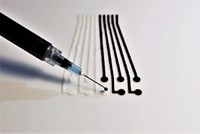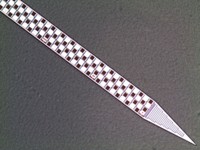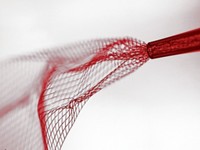Advertisement
Grab your lab coat. Let's get started
Welcome!
Welcome!
Create an account below to get 6 C&EN articles per month, receive newsletters and more - all free.
It seems this is your first time logging in online. Please enter the following information to continue.
As an ACS member you automatically get access to this site. All we need is few more details to create your reading experience.
Not you? Sign in with a different account.
Not you? Sign in with a different account.
ERROR 1
ERROR 1
ERROR 2
ERROR 2
ERROR 2
ERROR 2
ERROR 2
Password and Confirm password must match.
If you have an ACS member number, please enter it here so we can link this account to your membership. (optional)
ERROR 2
ACS values your privacy. By submitting your information, you are gaining access to C&EN and subscribing to our weekly newsletter. We use the information you provide to make your reading experience better, and we will never sell your data to third party members.
Analytical Chemistry
Tiny Probe Samples Chemicals Within Live Brains
Neurochemistry: Thin as a human hair, a silicon and aluminum microdialysis probe pinpoints ever smaller regions of rat and mouse brains
by Louisa Dalton
January 20, 2016

Microdialysis probes are useful little tools. They sample molecules in real-time from living tissue, often the brains of rats and mice. But some important regions of those brains are so small, they would be destroyed by the pokes from current probes. Now, chemists introduce a probe 80% thinner than conventional ones for sampling or delivering molecules to even smaller spaces (Anal. Chem. 2016, DOI: 10.1021/acs.analchem.5b03541).
For years, Robert T. Kennedy at the University of Michigan has been interested in miniaturizing microdialysis probes, thin capillaries with a semipermeable, dialysis membrane on the end that operate on the same physical principles as blood vessels. Liquid flows through the probes, which are slid into living tissue; the membrane allows small molecules within the tissue to diffuse across, while keeping larger proteins and macromolecules at bay. Researchers then scrutinize outgoing liquid with liquid chromatography-mass spectrometry or other analytical tools to detect escaping neurochemicals.
Kennedy’s team uses the probes to capture real-time chemical snapshots of various regions in the rat and mouse brain. But some important areas in the rat brain are almost as small as the probes themselves. And mouse brains are even smaller. Researchers can now study genetically engineered mouse models of neurological diseases such as Parkinson’s and Huntington’s, Kennedy says. Although microdialysis sampling of those brains could be useful, many researchers avoid mice entirely with current probes, he says.
The polymeric dialysis tubing used in current probes is at least 220 micrometers in diameter. Kennedy realized his group might be able to manufacture smaller probes by ditching the tubing and microfabricating the whole probe. They just needed to figure out how to create a semipermeable channel in a silicon probe.

They solved the problem by first etching a U-shaped trench on a silicon wafer and covering the trench with silicon to make an enclosed channel. Then they layered aluminum on top and anodized it. This peppered the aluminum with holes each tens of nanometers wide, creating a porous surface. Finally, an ion beam passing through each anodized aluminum pore etched aligned holes in the underlying silicon. The final silicon probe, with a four-millimeter-long surface of permeated silicon and anodized aluminum, is about as thick as a human hair and three or four times as wide: 45 by 180 micrometers.
“They look like pieces of glitter,” Kennedy says. Because the probes are too small to handle, Kennedy’s group also fabricated a silicon holder that joins capillaries to the inlet and outlet channels.
In a rat brain, the microfabricated probe recovered 14 out of a group of 18 neurochemicals; the conventional probe recovered all. Kennedy expects the small probe’s sensitivity to improve even further as they convert to more miniaturized techniques for testing the tiny volumes of liquid--as low as 1 or 2 microliters--that the small probe spits out. And the microfabricated probe followed the rise and fall of dopamine and five other neurochemicals in a rat’s brain just as well as the bigger probe--with 83% less damage to the brain.
For that reason, Kennedy expects that these smaller probes will be particularly useful in mice. He imagines adding electrodes or other sensors to the microdialysis probe and using the probe for delivery as well as sampling.
“The brain is a heterogeneous tissue,” says Susan M. Lunte at the University of Kansas. “If you are able to sample a smaller area, you may see some things you can’t see with the bigger probes.” This probe, she says, could be small enough for studying the brains of other small animals, such as amphibians. Dorian Liepmann at the University of California, Berkeley, thinks the probe has a great deal of promise. “Down the road,” he says, “there is potential for using this in a medical device.”





Join the conversation
Contact the reporter
Submit a Letter to the Editor for publication
Engage with us on Twitter